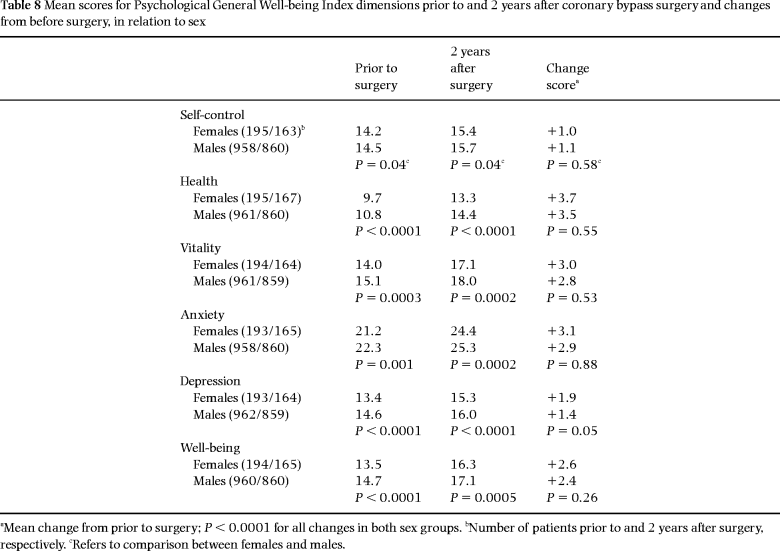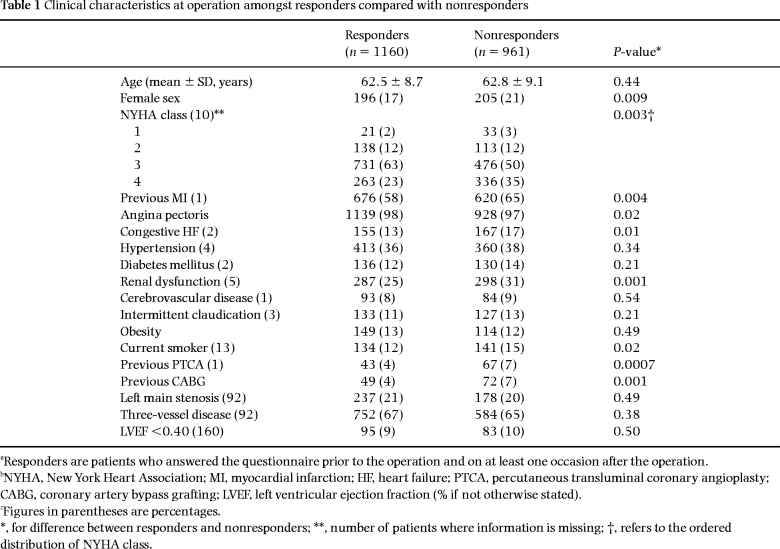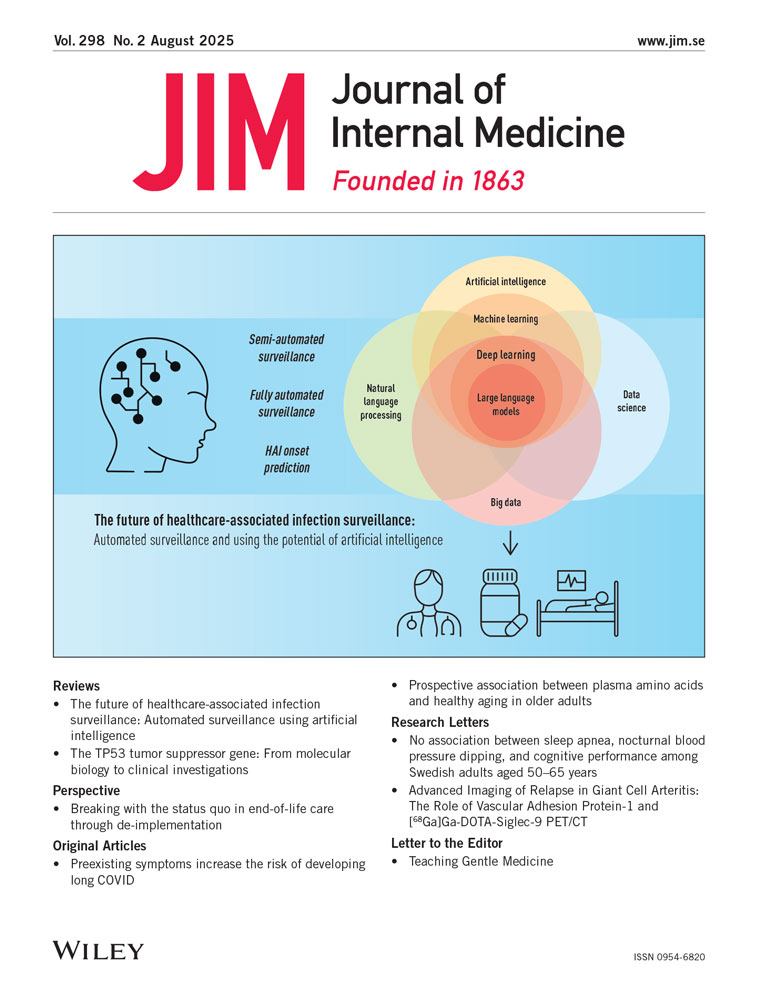Improvement in quality of life differs between women and men after coronary artery bypass surgery
Abstract
Abstract. Sjöland H, Wiklund I, Caidahl K, Hartford M, Karlsson T, Herlitz J (Sahlgrenska University Hospital, Göteborg, and Astra Hässle AB, Mölndal, Sweden). Improvement in quality of life differs between women and men after coronary artery bypass surgery. J Intern Med 1999; 245: 445–454.
Objective. To study improvement in quality of life (QoL) after coronary artery bypass grafting (CABG) in relation to gender.
Background. Women generally report worse QoL after CABG than men. However, women are older and more symptomatic prior to surgery, which should be considered in comparative analyses.
Methods. We studied consecutive patients who underwent CABG between 1988 and 1991 [n = 2121] with a QoL questionnaire containing the Physical Activity Score, the Nottingham Health Profile and the Psychological General Well-being Index prior to, 3 months, 1 year and 2 years after surgery.
Results. Females were older than men with more concomitant diseases preoperatively. QoL was improved on all postoperative occasions for both sexes. Improvement in the Physical Activity Score was somewhat, although not significantly, greater in males. Improvement in the Nottingham Health Profile was greater in females. General well-being showed no consistent pattern for improvement.
Conclusions. QoL is significantly improved after CABG in both sexes throughout follow-up. There is a complex association between improvement in various aspects of QoL and gender.
Introduction
Severe coronary artery disease can be successfully treated with coronary artery bypass grafting (CABG) with a considerable improvement in terms of the relief of angina pectoris [1–3] and improved survival in subgroups with advanced coronary disease [4, 5]. The prognosis after coronary surgery has been observed to be worse in women with higher operative mortality and lower short-term [6–8] and long-term survival [9, 10]. Women also have more severe preoperative angina and concomitant diseases [8, 10] and more reported symptoms after surgery [10, 11]. The improvement in quality of life (QoL) in men and women after CABG, utilizing reliable and validated instruments, has been little studied. Women who have suffered a myocardial infarction have been observed to report more symptoms of somatic as well as psychosocial origin than men [12, 13]. Similarly, women in a healthy population are characterized by reporting poorer well-being and a higher symptomatic complaint rate [14, 15]. Hence, the improvement in QoL after CABG cannot be adequately evaluated without taking into account the impact of gender and gender-related differences in comorbidity. This study evaluates QoL with a battery of three questionnaires, before and after CABG and the improvement in QoL in relation to gender. The outcome in relation to sex has previously been briefly reported and related to results of exercise testing [16].
Methods
All patients from all 15 hospitals in western Sweden who underwent CABG without concomitant valve surgery at Sahlgrenska University Hospital and the Scandinavian Heart Center in Göteborg between June 1988 and June 1991 (n = 2121), were approached with a questionnaire at the time of coronary angiography prior to the operation and 3 months, 1 year and 2 years after the operation. These two hospitals constitute referral centres for CABG in western Sweden (1.6 million inhabitants). The study was approved by the Ethics Committee at Göteborg University.
Quality of life
The patients completed three self-administered questionnaires for the assessment of QoL: the Physical Activity Score, the Nottingham Health Profile and the Psychological General Well-being Index. These questionnaires have been carefully validated and tested for reliability [17–20].
The Physical Activity Score represents one dimension of an angina-specific questionnaire [17], the Angina Pectoris Quality of Life questionnaire, which contains six questions, for the self-estimation of physical abilities and limitations. Each response is graded from 1 to 6 and the mean value for all six questions is calculated. The higher the total value, the greater is the degree of disability.
The Nottingham Health Profile is divided into two parts [18, 19]. Part I consists of 38 statements which convey limitations of activity or aspects of distress in six dimensions: physical mobility, pain, sleep, energy, social isolation and emotional reactions. Patients are required to indicate by a yes/no answer which of the problems they are experiencing at the time they complete the questionnaire. A score ranging from 0 to 100 can be calculated for each dimension of this part of the profile; the higher the score, the greater the limitations in activity or the distressing social and emotional problems. Part II lists the seven aspects of life which are found to be most affected by a person’s state of health: occupation, ability to perform jobs around the house, social life, home relationships, sexual life, hobbies and holidays; a yes/no answer indicates which areas are affected by the respondent’s present state of health.
The Psychological General Well-being Index contains 22 questions, dealing with six sections of well-being: anxiety, depressed mood, vitality, general health, self-control and well-being [20]. The response format is graded from 1 to 6 (total score range 22–132), with the highest value corresponding to superior well-being.
Statistical methods
Groups were compared (i.e. responders versus nonresponders and women versus men) using Mann–Whitney U-test for continuous/ordered variables and the chi-squared test for proportions. Interaction in Table 2 was analysed using the difference in log likelihood between logistic regression models with and without the interaction term in question. The Cochran–Mantel–Haenzel method was used for comparison between males and females when adjusting for age. Within-group comparisons over time were performed using Wilcoxon’s signed rank test and the sign test for continuous/ordered and dichotomous variables, respectively. We did not use the standard repeated measurement model because of the loss of information this would entail, as not all responders answered the questionnaire at all four occasions and therefore would be excluded from the analysis, thus further reducing the number of patients.
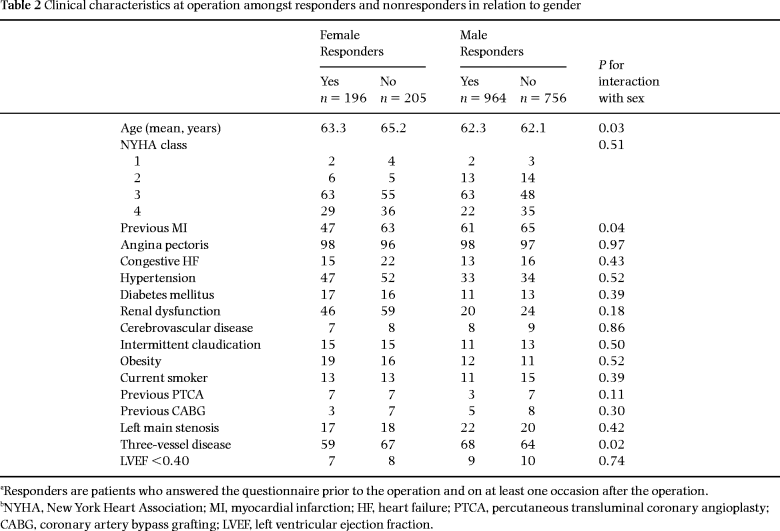
All P-values are two-sided and considered significant if below 0.01 in Tables 3,4,5,6,7,8.



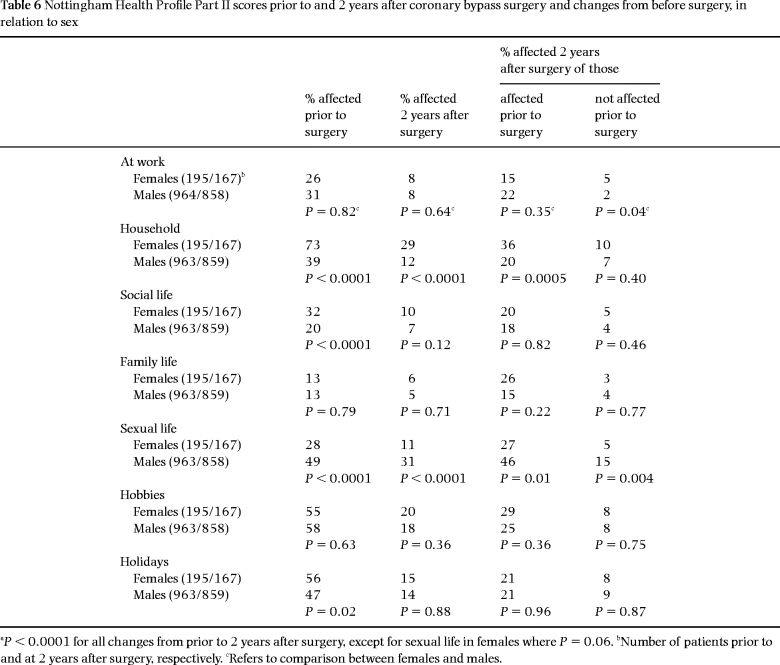
Results
Amongst all patients (n = 2121) 401, 19%, were females. In order to gain a more straightforward interpretation of the results, we used only responders defined as patients answering the questionnaire both preoperatively and on at least one of the three occasions during follow-up in the analysis. Thus, 196 females and 964 males (55% and 60%, respectively, of those surviving 2 years after operation), were included in the analysis. The mean delay time between coronary angiography and CABG was 126 days in women and 118 days in men (P = 0.35). At the time of surgery responders differed significantly from nonresponders on a number of items: Responders suffered more often from angina pectoris and included a higher proportion of males ( Table 1). The nonresponders represented a more clinically compromised group by suffering from more severe angina pectoris, and also more often had a history of myocardial infarction, congestive heart failure and renal dysfunction. They were more often smokers and had more often undergone a previous revascularization. In Table 2 responders are compared with nonresponders in men and women. A significant interaction with gender was found with regard to age, previous AMI and occurrence of triple vessel disease.
Measurements of quality of life
Physical activity score
The mean Physical Activity Score improved significantly in both males and females 3 months after surgery ( Table 3), with further slight improvement thereafter. Males assessed their physical abilities as significantly better (i.e. presented a lower Physical Activity Score) than females prior to surgery, and this difference remained throughout the duration of the follow-up. The actual improvement after CABG was somewhat, although not significantly, greater in males than in females at all points in time.
Nottingham Health Profile
The mean Nottingham Health Profile I total score improved significantly in both sexes 3 months after CABG ( Table 4), with stable results at 1 and 2 years after surgery. Male patients rated their QoL as significantly better (i.e. represented by a lower score) than females before and after CABG. However, the actual improvement in QoL was consistently greater in females throughout follow-up. The improvement reached statistical significance between preoperative and 2 year measurements for all dimensions in both sexes with the exception of social dimension in females (P = 0.05; Table 5). Female patients reported a more pronounced benefit with respect to emotions, sleep and mobility dimensions than male patients. The Nottingham Health Profile part II ( Table 6) showed an overall significant improvement in reported health problems 2 years after surgery, except for sexual life in females. Sexual life was more often reported as a health problem in the male patients prior to as well as 2 years after surgery, whilst the ability to perform household duties was significantly more affected in females on both occasions. When changes between pre- and postoperative occasions were compared, significantly more male patients assessed their householding abilities improved 2 years after CABG, whereas significantly more female patients reported improvement regarding sexual life. A significantly higher proportion of males reported their sexual life deteriorated.
Psychological General Well-being Index
The mean total score for the Psychological General Well-being Index and its dimensions improved significantly amongst both sexes 3 months after the operation and remained at similar levels throughout follow-up ( Tables 7 and 8). Men scored significantly higher than women in the total well-being score and in all the dimensions but self-control at all time-points, including the presurgery assessment. Nevertheless, improvement in the total score was somewhat, although not significantly, greater in females after CABG ( Table 7).
Discussion
Choice of questionnaires
We used a battery of questionnaires for evaluation of QoL in order to evaluate disease-specific and general impact of coronary disease and CABG in the patients operated on. Thus, the Physical Activity Score represents one dimension of a disease-specific questionnaire for the estimation of physical capacity in angina pectoris [17]. The Nottingham Health Profile and the Psychological General Well-being Index constitute general questionnaires. The Nottingham Health Profile is an instrument for measurement of health-related QoL and is most useful amongst patients with chronic and pronounced symptoms [21] and in the detection of treatment effects [22]. The Psychological General Well-being Index addresses the impact of symptoms on well-being and is applicable both for healthy and patient populations.
General results
In the general population women report more disease symptoms and worse QoL than men [14, 15]. Hence, worse results for QoL in women prior to and after an intervention are to be expected as a result of gender. Elderly people have lower exercise capacity [23] and have also been observed to report worse QoL than younger people in a healthy population [14]. Therefore, measurements of QoL in women and men undergoing CABG cannot be justly evaluated unless one takes age into account when exploring the comparative degree of improvement. Also, diabetes mellitus, renal dysfunction and obesity, as seen in a higher frequency in the female patients, have all been observed to influence QoL in a negative direction [24–26]. A higher proportion of concomitant diseases and higher age amongst female patients operated on are constant findings in patients undergoing CABG [8, 10, 27], and are found also in our study. These differences between men and women may account for better QoL and better physical abilities in males than in females at all points in time. However, the overall improvement in QoL in females after coronary bypass surgery tend to be equal to or greater than that in males. If our results are confirmed, they may have impact on referral patterns and timing of coronary bypass surgery in females.
The overall proportion of females operated on in our study was approximately 20%. As compared to recently published data from a number of databases and comprehensive studies this proportion may appear somewhat low [8, 10, 28, 29]. One must question whether this difference reflects variances in the underlying populations studied, or whether a selection bias in favour of allocating male patients to CABG was present in our study. The design of the study does not allow for an evaluation of this issue. However, if a selection bias was present, either at the level of preoperative investigation or at the level of selection for CABG, this would probably partly account for the increased symptoms, higher age, and comorbidity in the female patients, as compared to the males. All of these items would negatively affect QoL. However, with regard to prognostic factors, the proportional underutilization of CABG in women may not be disadvantageous but reflect good clinical judgement, since a number of studies have shown a higher overall mortality after CABG in women than in men [8, 10, 29, 30], and a comparatively better prognosis in women than men suffering from angina pectoris only [9, 27]. Also in our study, despite more severe chest pain, women that were operated on suffered from less advanced coronary disease and had better left ventricular function, which should be considered [8, 10].
Physical activity score
We have previously demonstrated a good correlation between exercise capacity on bicycle ergometer and the Physical Activity Score (r = – 0.56, P < 0.0001) after CABG [31]. Thus, the present results correspond with our previous finding of greater improvement in exercise capacity on bicycle ergometer after CABG in males than in females [32]. It is logical that younger age and less concomitant diseases (being found in men) may not only be associated with better physical ability but also with a greater potential for improvement. Also, male patients have generally been observed to be more likely to participate in rehabilitation for cardiovascular diseases than females, which may affect the outcome in terms of physical abilities [33, 34].
Nottingham Health Profile
According to the Nottingham Health Profile I women appear to have gained more in terms of health-related QoL from CABG at all time-points. This is important information about the benefit of CABG in women, since the majority of previous reports have stressed the inferior symptomatic outcome amongst women [10, 11, 35]. It is possible that the worse symptomatic outcome in women can mainly be explained by differences already prior to surgery. The dominance of pre- and postoperative householding problems in females, as well as their lesser improvement, may reflect the greater domestic responsibilities and demands on female patients in this respect.
Psychological General Well-being Index
As expected, men reached consistently superior scores. However, these results do not appear to be explained by higher age in women since our group have found that the Psychological General Well-being Index is better in elderly patients as compared with younger after CABG [36]. Other investigators have also found better mental health [37] and less psychological distress in elderly patients after CABG [38]. The improvement tended to be greater in women during the first year. This may indicate a tendency toward more rapid recovery after CABG in women.
Limitations
Responders differed from nonresponders in several clinical characteristics in a way that indicated that nonresponders generally suffered from more advanced cardiovascular disease. Furthermore, a lesser proportion of females responded to the questionnaire. The response rate was considerably lower prior to surgery, which was primarily due to administrative reasons or the fact that emergency surgery was performed, precluding the possibility to make an assessment at short notice. We have previously found that patients who are most symptomatic tend to improve their QoL the most after bypass surgery [32]. Therefore, we do not believe that the comparatively low preoperative response rate has overestimated the improvement in QoL.
One may argue that patients who did not respond to the questionnaires did so because they were the most symptomatic in terms of angina pectoris and suffered from more concomitant diseases ( Table 1). Their failing health would thus preclude their participation, and we would systematically misinterpret the benefits of the procedure. This makes it difficult to generalize our results to an unselected population of patients undergoing CABG. It has previously been reported that in QoL evaluations the sickest patients tend to be excluded [39] and with a longer follow-up more patients tend to be excluded [40, 41]. Similar results were found in this survey. Thus we do believe that our results can be generalized to a CABG population, where the sickest were excluded. However, this will always be an issue in every study demanding the personal participation, motivation and mental skills of the patient. Also, we were unable to distribute reminders, which would be likely to have increased the participation in the study.
Conclusions
QoL is significantly improved at all time-points up to 2 years after CABG. Men estimate their physical abilities, health-related QoL and general well-being as better than females prior to and after surgery. The association between improvement in various aspects of QoL and gender is complex. The most striking finding was a better improvement in health-related QoL in women.
Acknowledgements
This study was supported by grants from the Swedish Heart and Lung Foundation, Stockholm, and the Göteborg Medical Society, Gothenburg, Sweden.
References
Received 7 October 1997; accepted 28 October 1998.




